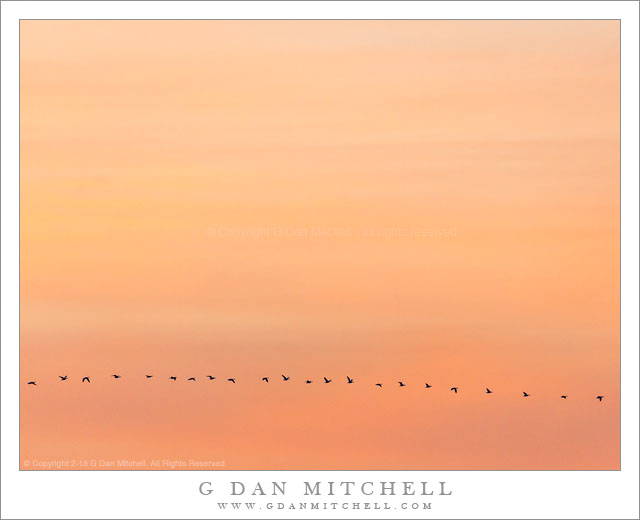Ross’s Geese, Dusk Sky. San Joaquin Valley, California. January 21, 2013. © Copyright 2013 G Dan Mitchell – all rights reserved.
A row of Ross’s geese stretches into a line as they fly in front of dusk sky on a winter evening above California’s San Joaquin Valley.
The post-sunset twilight period is one of the most special of the day in these Central Valley wildlife refuges. There is a transformation at this point that fascinates me, even after seeing it a number of times. During the day, it often seems that not much is going on. The larger flocks of birds are mostly settled in somewhere, with only small numbers flying from place to place, albeit with an occasional momentary eruption of geese. As sunset approaches, the geese become more active, taking flight and moving from location to location. On this evening, the process was mostly one of leaving rather than arriving, as the flock nearest to us gradually left the pond where they had been settled and then flew off to more distant points. As the sun sets the wildlife seems like it is going to settle down. But then, as darkness comes on, special things happen. In this particular location, just as things quiet, the cranes return. Unlike the geese, who flap and squawk, the cranes have a distinctive and less raucous cry and then float in with much less flapping of wings. And at close to this same time, I often begin to notice that geese are flying in smaller groups all throughout the sky. At this San Joaquin Valley location, it can seem that they stretch all the way to the Diablo Range to the west. Simultaneous with this, if there are clouds in the sky, they take on the rich post-sunset colors that can perhaps be seen better by the camera than the eye.
The idea of this photograph was simple. I wanted to find and photograph a line of geese in front of a colorful section of the dusk sky. To make this work, I have to become aware of cloud patterns and where the most colorful portions of the sky are, and both clouds and colors are in a constant state of change. As groups of birds fly into view I try to guess which of them might follow a path across these areas of the sky, at which point I pick up a group in the viewfinder and follow it as it crosses into the scene. I am probably less attentive to the birds than to the non-bird portions of the scene that slide across my viewfinder, and I wait until the birds appear against a particular pattern or color of sky and clouds to make exposures. Obviously, little of this is in my control beyond the timing of my attempts to take advantage of whatever the sky and the birds happen to provide to me! In some ways, it still amazes me that it is possible to capture a simple scene like this one. Both technique and equipment play an important role here. In order to work with birds that may be a good distance away and in order to constrain my field of view to small sections of the sky, I work with a 400mm focal length. I must hand hold the camera rather than using the tripod, adding an additional challenge. By this time the light is so low that I find myself shooting at ISO 3200, something that would have been darned near impossible even a few years ago. And somehow, in light that is rapidly fading toward darkness, it is possible to photograph a moving flock of birds against a dusk sky.
G Dan Mitchell is a California photographer and visual opportunist. His book, “California’s Fall Color: A Photographer’s Guide to Autumn in the Sierra” (Heyday Books) is available directly from him.
G Dan Mitchell: Blog | Bluesky | Mastodon | Substack Notes | Flickr | Email
All media © Copyright G Dan Mitchell and others as indicated. Any use requires advance permission from G Dan Mitchell.
Discover more from G Dan Mitchell Photography
Subscribe to get the latest posts sent to your email.


Thanks, Craig.
You are right that I did not mention that “sharpness” issue directly, but I sure did think about it – and that thought was behind some of what I wrote in the second paragraph of description for this photograph.
It, along with a couple of other photographs I made under similar conditions, got me thinking about how the equipment we work with today makes a lot of things possible that might have been either tremendously difficult or even impossible just a few years ago. While I like to think that there is more to a photograph like this than its technical merit, in this case that sharpness of the individual birds is important. And they are quite sharp, more so that these little jpg images reveal.
Take care,
Dan
Beautiful minimalist image, like a visual haiku or tone poem. You don’t mention it, but I doubt that this would be so successful without each tiny silhouette being in such sharp focus.